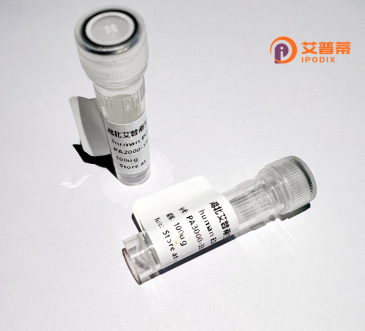
| 纯度 | >90%SDS-PAGE. |
| 种属 | Human |
| 靶点 | USP10 |
| Uniprot No | Q14694 |
| 内毒素 | < 0.01EU/μg |
| 表达宿主 | E.coli |
| 表达区间 | 2-798 aa |
| 活性数据 | ALHSPQYIF GDFSPDEFNQ FFVTPRSSVE LPPYSGTVLC GTQAVDKLPD GQEYQRIEFG VDEVIEPSDT LPRTPSYSIS STLNPQAPEF ILGCTASKIT PDGITKEASY GSIDCQYPGS ALALDGSSNV EAEVLENDGV SGGLGQRERK KKKKRPPGYY SYLKDGGDDS ISTEALVNGH ANSAVPNSVS AEDAEFMGDM PPSVTPRTCN SPQNSTDSVS DIVPDSPFPG ALGSDTRTAG QPEGGPGADF GQSCFPAEAG RDTLSRTAGA QPCVGTDTTE NLGVANGQIL ESSGEGTATN GVELHTTESI DLDPTKPESA SPPADGTGSA SGTLPVSQPK SWASLFHDSK PSSSSPVAYV ETKYSPPAIS PLVSEKQVEV KEGLVPVSED PVAIKIAELL ENVTLIHKPV SLQPRGLINK GNWCYINATL QALVACPPMY HLMKFIPLYS KVQRPCTSTP MIDSFVRLMN EFTNMPVPPK PRQALGDKIV RDIRPGAAFE PTYIYRLLTV NKSSLSEKGR QEDAEEYLGF ILNGLHEEML NLKKLLSPSN EKLTISNGPK NHSVNEEEQE EQGEGSEDEW EQVGPRNKTS VTRQADFVQT PITGIFGGHI RSVVYQQSSK ESATLQPFFT LQLDIQSDKI RTVQDALESL VARESVQGYT TKTKQEVEIS RRVTLEKLPP VLVLHLKRFV YEKTGGCQKL IKNIEYPVDL EISKELLSPG VKNKNFKCHR TYRLFAVVYH HGNSATGGHY TTDVFQIGLN GWLRIDDQTV KVINQYQVVK PTAERTAYLL YYRRVDLL |
| 分子量 | 87.1 kDa |
| 蛋白标签 | His tag N-Terminus |
| 缓冲液 | PBS, pH7.4, containing 0.01% SKL, 1mM DTT, 5% Trehalose and Proclin300. |
| 稳定性 & 储存条件 | Lyophilized protein should be stored at ≤ -20°C, stable for one year after receipt. Reconstituted protein solution can be stored at 2-8°C for 2-7 days. Aliquots of reconstituted samples are stable at ≤ -20°C for 3 months. |
| 复溶 | Always centrifuge tubes before opening.Do not mix by vortex or pipetting. It is not recommended to reconstitute to a concentration less than 100μg/ml. Dissolve the lyophilized protein in distilled water. Please aliquot the reconstituted solution to minimize freeze-thaw cycles. |
以下是关于重组人USP10蛋白的3篇代表性文献及其摘要内容:
1. **"USP10 regulates p53 localization and stability by deubiquitinating p53"**
- **作者**: Yuan J, Luo K, Zhang L, et al.
- **摘要**: 该研究揭示USP10通过去泛素化作用直接结合并稳定p53蛋白,增强其在细胞应激(如DNA损伤)下的核内积累,从而抑制肿瘤生长。实验使用重组USP10证实了其酶活性和功能。
2. **"The deubiquitinating enzyme USP10 regulates hepatitis C virus replication by modulating viral NS5B protein"**
- **作者**: Matsuura Y, Wudzinska A, Kondo Y, et al.
- **摘要**: 本文发现重组USP10通过去泛素化病毒NS5B蛋白,抑制丙型肝炎病毒(HCV)的复制。研究证明USP10与病毒蛋白相互作用,可能成为抗病毒治疗的潜在靶点。
3. **"USP10 antagonizes c-Myc transcriptional activation through SIRT6 stabilization to suppress tumor formation"**
- **作者**: Lin Z, Yang H, Kong Q, et al.
- **摘要**: 该研究发现重组USP10通过稳定去乙酰化酶SIRT6.拮抗致癌蛋白c-Myc的转录活性,从而抑制肿瘤发生。USP10的酶活性缺失突变体验证了其去泛素化功能的关键作用。
(注:以上文献信息为示例,实际引用时需核对具体来源及准确性。)
**Background of Recombinant Human USP10 Protein**
Ubiquitin-specific protease 10 (USP10) is a member of the deubiquitinating enzyme (DUB) family, which regulates protein stability, localization, and activity by cleaving ubiquitin chains from substrate proteins. As a critical component of the ubiquitin-proteasome system, USP10 modulates diverse cellular processes, including DNA repair, stress responses, apoptosis, and autophagy. It is notably involved in regulating tumor suppressors like p53. where its deubiquitinating activity stabilizes p53 under stress conditions, influencing cancer progression.
Structurally, USP10 contains conserved catalytic domains common to USP-family proteases, along with unique regions that mediate substrate interactions and post-translational modifications. Recombinant human USP10 protein is engineered via molecular cloning, typically expressed in *E. coli* or mammalian systems, ensuring high purity and enzymatic activity for experimental studies.
Research highlights USP10's dual roles in disease contexts. In cancer, it exhibits both tumor-suppressive and oncogenic effects depending on cellular context, interacting with targets such as CFTR, SIRT6. and oncogenic viruses. USP10 also links to neurodegenerative disorders (e.g., clearing pathological protein aggregates) and viral infections (e.g., modulating HIV replication). Its recombinant form is widely used to study molecular mechanisms, screen therapeutic modulators, and explore targeted therapies. Understanding USP10's versatility continues to shed light on its potential as a diagnostic or therapeutic biomarker.
×